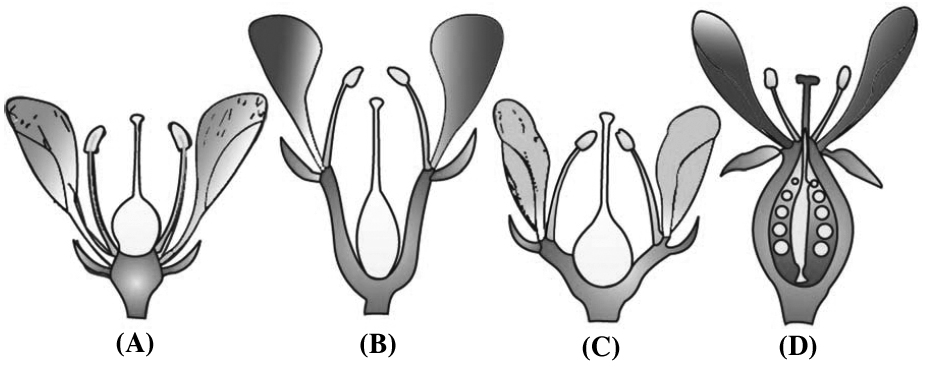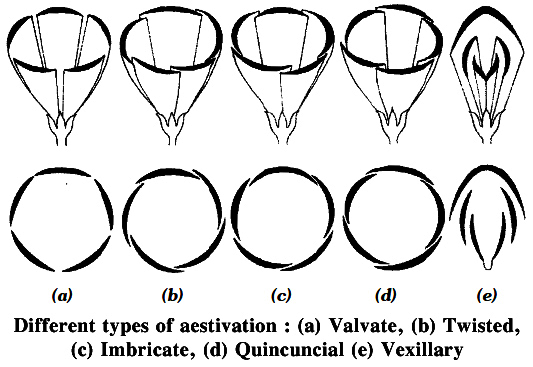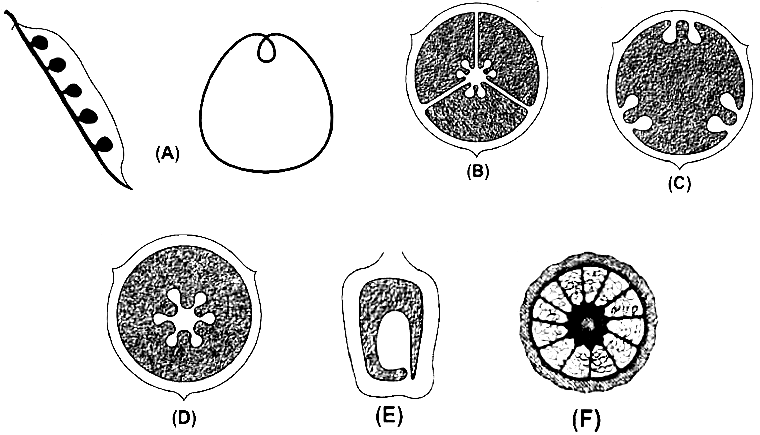- Books Name
- ACME SMART COACHING Biology Book
- Publication
- ACME SMART PUBLICATION
- Course
- CBSE Class 11
- Subject
- Biology
THE FLOWER
Flower is defined as a highly condensed and modified reproductive shoot.
Instead of leaves the apex produces different kinds of floral appendages laterally at successive nodes.
Following points can be mentioned to justify that flower is a modified shoot:
(1) Calyx, corolla, androecium and gynoecium represent four whorls of sterile and fertile leaf modifications borne at different nodes.
Sometimes, internode between calyx and corolla becomes elongated and called as anthophore, e.g., Silene Dianthus.
The internode between corolla and androecium is known as androphore, e.g., Passiflora.
The internode between androecium and gynoecium is called as gynophore e.g., Capparis.
When androphore and gynophore both are present in the same flower they are jointly termed as gynandrophore e.g., Cleome gynandra.
The prolongation of thalamus beyond carpel is known as carpophore, e.g., Coriandrum, Foeniculum.
(2) In Mussaenda, one sepal enlarges to form leafy structure (foliaceous sepal).
(3) Sometimes, floral bud gets transformed into vegetative bud or bulbil. e.g., Agave.
Concept Builder
Terminology used w.r.t. flower
(i) Complete flower: All four whorls (calyx, corolla, androecium and gynoecium) are present.
(ii) Incomplete flower: Flower with anyone of the four whorls missing.
(iii) Bisexual flower: Both gynoecium and androecium are present in the same flower.
(iv) Unisexual flower: Either androecium (staminate flower) or gynoecium (pistillate flower) is present in the flower.
(v) Monoecious plant: When both male and female flowers are present on the same plant e.g., Cocos, Ricinus, Zea, Colocasia, Acalypha.
(vi) Dioecious plant: When male and female flowers are present on separate plants e.g., Mulberry, Papaya.
(vii) Polygamous plant: When unisexual (male or female) , bisexual and neuter flowers are present on the same plant e.g., Polygonum, Mango.
(viii) Achlamydeous flower: Flowers are naked i.e., without sepals and petals e.g., Piperaceae.
(ix) Monochlamydeous flower :Only one whorl is present (perianth) e.g., Polygonaceae, Liliaceae.
(x) Dichlamydeous flower: Both whorls (calyx and corolla) present in a flower e.g., most of the flowers.
(xi) Hemicyclic or spirocyclic flowers: Some of the floral parts form circles and some are spirally arranged e.g., Ranunculaceae.
(xii) Cauliflory: Production of flowers on old stem from dormant buds e.g., Artocarpus, Ficus.
Symmetry of Flower
(i) Actinomorphic flower. When a flower can be divided into two equal halves by many vertical sections passing through the centre. e.g., Cruciferae, Malvaceae.
(ii) Zygomorphic flower. When a flower can be divided into two equal halves by only one vertical section passing through the centre. e.g., Pea.
Position of Floral Parts on Thalamus
(i) Hypogyny. Ovary is at the top and separable from thalamus. Such flowers are called hypogynous and ovary is said to be superior. e.g. , Malva, Brassica.
(ii) Perigyny. Ovary is situated in centre and other parts of the flower are located on the rim of thalamus, almost at the same level. Ovary is half superior, half inferior. e.g., Rose.
(iii) Epigyny. Calyx and corolla arise from upper side of ovary. Ovary is completely surrounded by and fused with thalamus. Ovary is called inferior and flower is said to be epigynous e.g., Aster, Luffa.

(A) Hypogynous, (B) and (C) Perigynous, (D) Epigynous
Bracts
Bracts are specialized leaves bearing flower in the axil. They are of following types:
(i) Petaloid bracts. Bracts look like petals (brightly coloured). e.g., Bougainvillea.
(ii) Spathy bract. This is large bract enclosing an inflorescence. e.g., Banana, Maize, Palms.
(iii) Foliaceous bracts. Bracts are leaf like in appearance e.g., Adhatoda, Gynandropsis.
(iv) Involucre. They are green coloured and in one or more whorls around or below the entire inflorescence. e.g., Sunflower, Coriander.
(v) Glumes. These are small, dry, scaly bracts found in spikelet of Gramineae. e.g., Wheat.
All floral whorls are described respectively :
A. Calyx
Outermost whorl of a flower is called calyx. It is the non-essential whorl and consists of sepals. Sepals may be free (polysepalous) or fused (gamosepalous). Sepals are modified as follows :
(i) Pappus. Sepals are modified into persistent hairy structures called pappus which help in dispersal of fruits. e.g., Sunflower, Sonchus. (Asteraceae) .
(ii) Leafy. In Mussaenda, one sepal gets modified into large leaf like white structure.
(iii) Spinous. In Trapa , the calyx is persistent and modified into two spines.
B. Corolla
It is second whorl of flower and consists of a number of petals which are usually bright coloured. The petals may be fused (gamopetalous) or free (polypetalous).
Concept Builder
Various forms of petals are :
(i) Cruciform. Four petals arranged like a cross e.g. , members of Brassicaceae.
(ii) Papilionaceous. Number of petals is five with largest petal standard or vexillum, enclosing two lateral petals called wings or alae which are free, these in turn enclose the inner most petals called keel or carina (united petals) , e.g. , Pea.
(iii) Caryophyllaceous. Five, free, long, clawed corolla, with limbs spreading at right angles to claws. e.g., Dianthus.
(iv) Tubular. Petals are like a tube, e.g. , disc florets of sunflower.
(v) Campanulate or bell shaped. Petals are like a bell, e.g., Physalis.
(vi) Infundibuliform or funnel shaped. Petals are like funnel, e.g., Datura .
(vii) Bilabiate (two lipped). Upper and lower lips are formed by fusion of petals, e.g., Salvia, Ocimum.
(viii) Ligulate or strap shaped. Gamopetalous petals forming tongue like structure, e.g., Ray florets of Sunflower.
(ix) Personate. Corolla is bilabiate, but the lips are so near to each other as to close the mouth of the corolla, e.g., Antirrhinum.
Aestivation
Arrangement of floral parts in a floral bud with respect to the other members of the same whorl is known as aestivation. It may be of following types.
(i) Valvate. When sepals or petals lie very close to each other, without overlapping e.g., Mustard.
(ii) Twisted or contorted. When one margin of the sepal or petal overlaps the margin of next and other margin is overlapped by the third one. e.g., China rose.
(iii) Imbricate. When both margins of one of the petals are covered by others and both margins of another one are external and of the remaining partly internal, partly external. e.g., Cassia, Caesalpinia.
(iv) Quincuncial. When two petals are inner, two are outer and one is partly outer and partly inner e.g., Ranunculus.
(v) Vexillary. The posterior one is largest and almost covers the two lateral petals and the latter in turn nearly overlap the two anterior petals, e.g. , Pea (Papilionaceae).

C. Androecium
Androecium is the third and male whorl of the flower and is made up of one or more stamens (equivalent to microsporophylls).
Each stamen consists of filament, anther and connective. The two lobed anther is called bithecous anther e.g., Pea.
The anther with one lobe is called monothecous anther. e.g., members of Malvaceae.
When stamens are free from each other the condition is called polyandrous, e.g., lily, mustard.
A sterile stamen is called staminode.
Cohesion of Stamens
Fusion of stamens among themselves is called cohesion.
(i) Monadelphous. Stamens may be united by means of their filaments in one bundle with free anthers. e.g., China rose, lady's finger, cotton (Malvaceae).
(ii) Diadelphous. When the filaments are united into two bundles and the anthers remain free, e.g., Pea, bean, gram (Papilionaceae).
(iii) Polyadelphous. When the filaments are united into more than two bundles but anthers are free e.g., Castor (Euphorbiaceae), Lemon (Rutaceae)
(iv) Syngenesious. When anthers are united but the filaments are free, e.g., Sunflower (Compositae).
(v) Synandrous. When anthers as well as filaments of stamens are united throughout their whole length, e.g. , members of Cucurbitaceae.
Adhesion of Stamens
Fusion of stamens with other floral parts.
(i) Epipetalous. When stamens are united to the petals. e.g., China rose, Solanum, Sunflower.
(ii) Episepalous. When stamens are united to sepals. e.g., Verbena.
(iii) Epiphyllous (Epitepalous). When stamens are united to perianth (Tepal). e.g., members of Liliaceae.
(iv) Gynandrous. When stamens are attached to gynoecium (carpel) either throughout their whole length or by their anthers only, e.g., Calotropis, (forming gynostegium).
Length and arrangement of Stamens
(i) Didynamous. 4 stamens, two outer small and two inner long, e.g., Ocimum, Salvia (Lamiaceae).
(ii) Tetradynamous. 6 stamens, two outer small and four inner long, e.g., Mustard, Radish (Brassicaceae).
(iii) Heterostemony. Stamens are of different lengths, e.g., Cassia.
Concept Builder
Obdiplostemonous condition:
Two whorls of stamens, outer lying opposite to the petals (anti-petalous) and inner whorl lying opposite to sepals (anti-sepalous), e.g., Stellaria, Spergula and members of Rutaceae.
Diplostemonous condition:
Two whorls of stamens, outer whorl lying opposite to sepals (antisepalous) and inner whorl lying opposite to petals (antipetalous), e.g., Cassia.
D. Gynoecium
It is the female part of flower comprising of carpels bearing ovules.
It consists of ovary, style and stigma.
The gynoecium may be monocarpellary (one carpel) or polycarpellary (many carpels).
Cohesion of Carpels
(i) Apocarpous. Carpels are free (no cohesion), e.g., Ranunculaceae.
(ii) Syncarpous. Carpels more than two and fused, e.g., most of the plants.
Number of locules. Ovary has locules or chambers having ovules and may be unilocular, bilocular, trilocular, tetralocular or pentalocular (multilocular).
Placentation
The arrangement of ovules on placenta within the ovary is called placentation.
It is of following types:
(i) Marginal. Placenta developing along the junction of the two margins of the carpel in one chambered ovary. It is characteristic feature of family Leguminosae. e.g., Pea, gram.
(ii) Axile. The ovary is two to many chambered and placenta bearing ovules develop from the central axis e.g., Tomato, orange, cotton, china rose, lily. (A)

(E) Basal; (F) Superficial
(iii) Parietal. Ovary is one chambered and the placenta bearing the ovules develop close to the inner wall of the ovary, e.g., Mustard, radish, cucumber, Argemone.
(iv) Free central. Ovary is one chambered and the placenta bearing the ovules develop all round the central axis. Septa are absent, e.g., Dianthus, Stellaria.
(v) Basal. Ovary is unilocular and the placenta develops at the base of ovary on thalamus and bears a single ovule, e.g. , Wheat, maize, Aster, Zinnia, sunflower. It is most advanced.
(vi) Superficial. Ovary is multilocular with numerous carpels as in axile type of placentation but placenta develops all round the inner surface of the partition wall, e.g., Water lily. It is most primitive.
Style. It is generally terminal but may be lateral, e.g., Poaceae, mango.
Gynobasic style arises from base of the ovary, e.g., Lamiaceae.

 Maria Habib
Maria Habib
